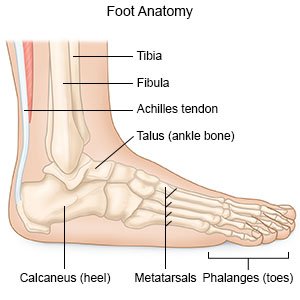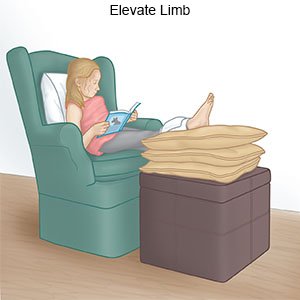Toe Fracture in Children
Medically reviewed by Drugs.com. Last updated on Apr 6, 2025.
What is a toe fracture?
A toe fracture is a break in a bone in your child's toe.
 |
What are the signs and symptoms of a toe fracture?
- Pain, redness, swelling, or bruising
- Not being able to bend or move the toe
- Not being able to walk or put weight on the toe
- Toe is bent at an angle that is not normal
How is a toe fracture diagnosed?
Your child's healthcare provider will examine your child and ask about the injury. Your child may also need any of the following:
- An x-ray may show a toe fracture.
- A MRI may show a stress fracture or ligament damage. Your child may be given contrast liquid to help an injury show up better in pictures. Tell a healthcare provider if your child has ever had an allergic reaction to contrast liquid. Do not let your child enter the MRI room with anything metal. Metal can cause serious injury. Tell a healthcare provider if your child has any metal in or on his or her body.
How is a toe fracture treated?
- Buddy tape, an elastic bandage, or a splint may be used to support your child's toe in its correct position. Buddy tape means the fractured toe and the toe next to it are taped together.
- A support device such as a cane, crutches, walking boot, or hard-soled shoe may be needed. These help protect your child's broken toe and limit movement so it can heal.

- Medicines may be given to prevent or treat pain or a bacterial infection.
- Closed reduction is used to move your child's bones back into place without surgery.
- Surgery may be needed for a more severe break. Wires, pins, or other hardware may be used to keep the bone in place while it heals.
How can I help manage my child's symptoms?
- Help your child rest so the toe can heal. He or she can return to normal activities as directed.
- Apply ice on your child's toe for 15 to 20 minutes every hour or as directed. Use an ice pack, or put crushed ice in a plastic bag. Cover it with a towel. Ice helps prevent tissue damage and decreases swelling and pain.
- Elevate your child's toe above the level of the heart as often as you can. This will help decrease swelling and pain. Prop your child's toe on pillows or blankets to keep it elevated comfortably.

When should I seek immediate care?
- Your child has severe pain in his or her toe.
- Your child's toe is cold or numb.
When should I call my child's doctor?
- Your child has a fever.
- Your child's pain does not go away, even after treatment.
- Your child's toe continues to hurt even after it has healed.
- You have questions or concerns about your child's condition or care.
Care Agreement
You have the right to help plan your child's care. Learn about your child's health condition and how it may be treated. Discuss treatment options with your child's healthcare providers to decide what care you want for your child. The above information is an educational aid only. It is not intended as medical advice for individual conditions or treatments. Talk to your doctor, nurse or pharmacist before following any medical regimen to see if it is safe and effective for you.© Copyright Merative 2025 Information is for End User's use only and may not be sold, redistributed or otherwise used for commercial purposes.
Learn more about Toe Fracture
Care guides
Further information
Always consult your healthcare provider to ensure the information displayed on this page applies to your personal circumstances.
